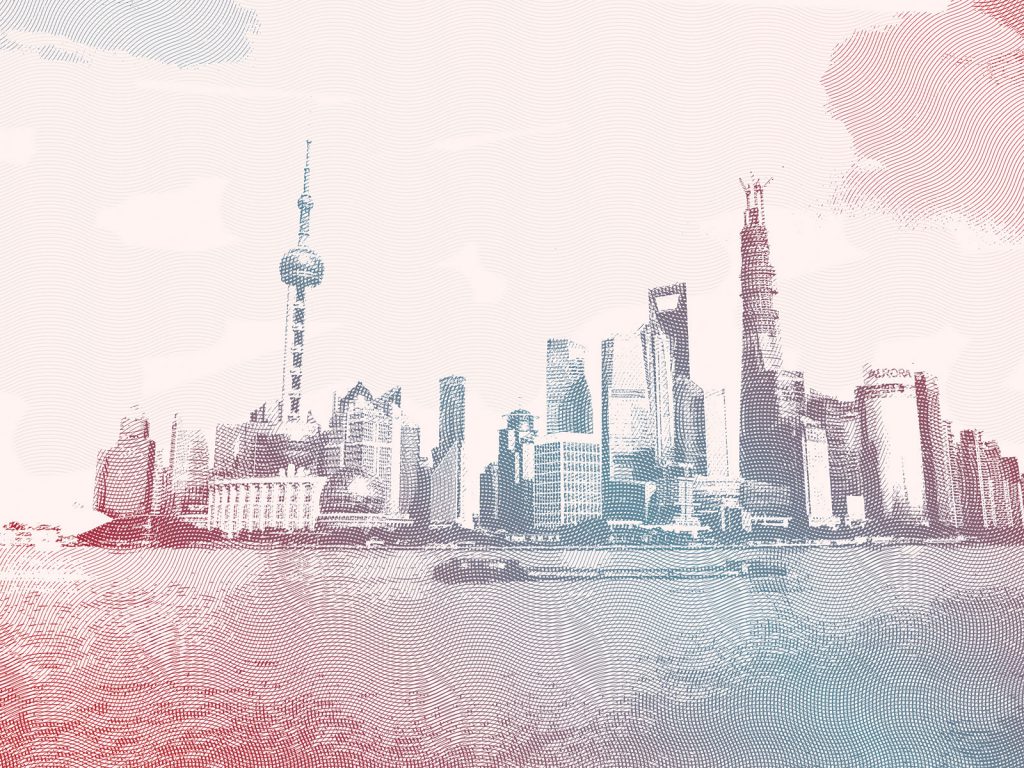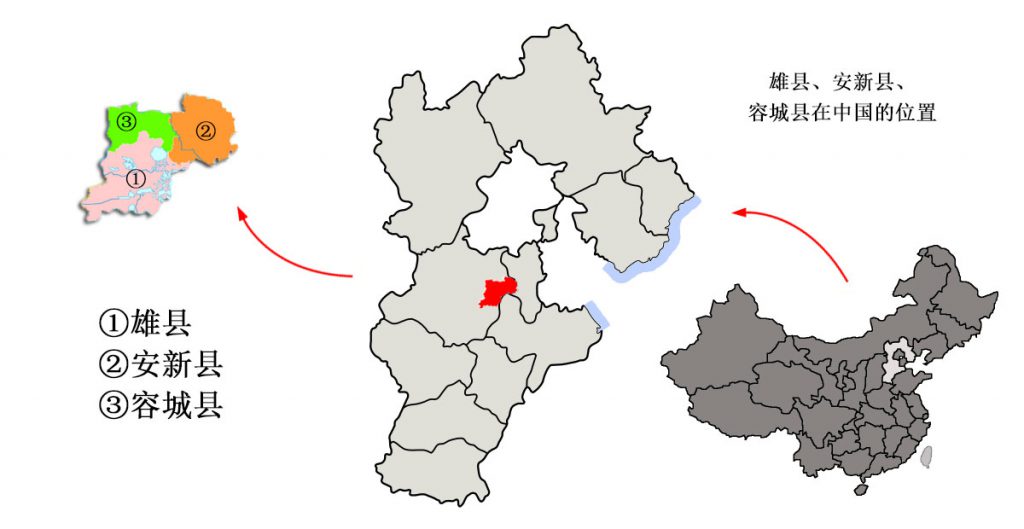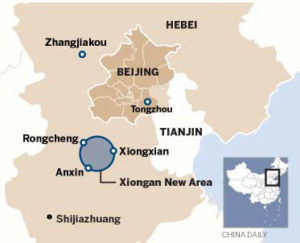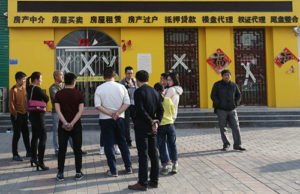ON 1 APRIL 2017, the Chinese Communist Party Central Committee and the State Council announced the establishment of Xiongan New Area 雄安新区 in southern Hebei province, on the historic periphery of the Beijing capital region. Despite the anodyne category of its name, ‘new area’ or xinqu 新区, it is a significant event in the history of China’s urban development. The nondescript phrase ‘new area’ suggests the magic of Shanghai Pudong, with its super-tall financial centre, expansive cultural facilities, glittery Oriental Pearl Tower, maglev airport train, and Shanghai Disneyland. Pudong, the original national-level New Area, rose from the eastern bank of the Huangpu River to become one of the most successful and spectacular urban developments in China.
The term New Area is also China’s development-planning language for a higher standard of ‘special zone’ 特区, one whose conditions will surpass those of the historic special economic zones led by Shenzhen in the 1980s. China’s leadership chose the term ‘New Area’ to distinguish Pudong from the early manufacturing zones like Shenzhen. A New Area has high-technology industry, a green urban environment, and a spectrum of leisure and consumer opportunities. It is a ‘creative city’ with good schools, well served by public transportation and connected to regional inter-urban rail lines as well as the latest style and standard in high-rise housing, offering investors the possibility of making a fortune in real estate. Xiongan is the nineteenth state-level New Area but it is also the most important New Area since Pudong.
‘No one had ever heard of Xiongan,’ The Economist observed, yet now ‘it’s the most talked-about place in China.’ A Google search cannot retrieve it on the map of Hebei province — because it does not yet exist on the map. Xiongan is a new name for a new administrative division. It merges three historic counties — Anxin 安新, Rongcheng 荣成, and Xiongxian 雄县 — by abolishing their governments and combining them to establish a new territory that will be jointly governed by the Hebei Province Party Committee in Shijiazhuang, the provincial capital, the Jing-Jin-Ji Cooperative Development Leading Small Group, and the State Council. Xiongan combines words from Xiongxian and Anxin to form a new place name. Its simplest literal translation is ‘powerful peace’. But the word xiong has mutliple meanings in history, including male, chieftan, hero, victory, grand, imposing, bold, and unconstrained. Named for the Xi Jinping era, Xiongan is the latest example of how China changes its subnational territory to establish new cities in a process of planned uneven development.
Xiongan is the focus of a long-term Chinese central government plan to redistribute the population and economy from Beijing to surrounding areas. The equivalent in Australia would be if Canberra was the size of Brisbane, Melbourne, and Sydney combined, and then grew beyond its resource limits and the government responded by building an ‘overflow’ city at a distance in an adjacent state. Located in the region of Beijing, but not in Beijing, Xiongan is a new city for Beijing. The central government introduced new plans for the capital region (as discussed in the China Story Yearbook 2015), in response to evidence that Beijing had already breached its planned growth limits. Its water supply is insufficient for continued population and industrial growth. The 2004–2020 Beijing Urban Master Plan projected a maximum population of eighteen million, but by 2016 Beijing was home to 21.5 million. Now the Beijing 2016–2030 plan aims to limit the population to twenty-three million. To alleviate the problems, the central government has decreed that ‘non-capital functions’ 非首都功能, unrelated to Beijing’s status of national capital, will be relocated outside the city. The main solution is the Xiongan New Area.
Construct!
China debuted the economic development model of production-led growth, based on state investment in construction and land development, in the 1980s, with China’s opening to the world economy. Xinhua, the state news agency, has described Xiongan as a historically strategic decision for the Chinese Communist Party that follows in the path of the Shenzhen Special Economic Zone — the leading development area of the 1980s — and the Shanghai Pudong New Area in the 1990s. This official discourse works in two ways. Just as Shenzhen represents the Deng Xiaoping era and Pudong that of Jiang Zemin, Xiongan New Area is a symbol of the core leadership of Xi Jinping.
Internationally, publicity about the construction of Xiongan continues the practice that economist Barry Naughton describes as ‘signalling’: communicating to world markets that China is in the business of economic growth. International investment firms calculate that the state will invest between two and four trillion yuan (US$290–580 billion) over the next fifteen to twenty years in Xiongan. This is good news for China’s steel production, which, coincidentally, is concentrated in Hebei province. From an initial one hundred square kilometres, Xiongan will expand to 2,000 square kilometres by 2050. Official publicity calls it a ‘great plan for the millennium and a major state project’ 千年大计, 国家大事.
Environmentally Speaking
Compared to Beijing, Xiongan has ample water resources, at least in theory. Party-state propaganda describes Xiongan’s ‘relatively clean natural environment’ including the ‘largest freshwater lake’ in the North China Plain. The echo chamber of official media describes the area as ‘ecologically healthy’ because it includes the ‘freshwater lake’ of Baiyangdian, which lies at the centre of former Anxin county. Scientific reports about Baiyangdian tell a different story.
Baiyangdian is an inland wetland ecosystem that expands and contracts with the rainy season, the flow of the Hai River that feeds it, and the vagaries of the water table. A dian 淀 is a shallow lake emerging in a seasonal wetland or marsh. Marshes in China, as elsewhere, were historically treated as swamps and classified as wasteland. Now, however, Baiyangdian is recognised as the natural ‘kidney of north China’ for filtering the waters of the Hai River and providing habitat for migratory birds in the Asian flyway.

Map of the administrative division of Anxin county
Source: Anxin County Annals 安新县志, Xinhua Press, 2000
The problem is that over the past four decades, Baiyangdian’s ephemeral meres and ponds have shrunk by up to one-half of their historic area. More than one hundred dams have been built upriver on the Hai and its tributaries for flood control, hydropower, and reservoirs. Significant amounts of water are drawn off by industry including by small-scale plastics factories in the area. From 1983 to 1988 Baiyangdian was dry. Since the 1950s, annual rainfall has dropped nearly twenty per cent and average temperature has risen 2.5 degrees centigrade while population has doubled. Local farmers have reclaimed former shorelines and extracted groundwater for irrigation. And today, like so much water elsewhere in China, the marsh has become heavily polluted from local and upstream sources. A 2012 Chinese government report found water pollution worse than grade five or too toxic to touch. The Chinese government has separately announced a ten-year effort to clean up Baiyangdian, but a reliable restoration will take much longer. Only with central government support is the Baiyangdian ecosystem likely to be restored.

Map of the river system of Baiyangdian showing the relationship between the three counties
Source: Li, Aiguo (李爱国), Baiyangdian Annals (白洋淀志), (中国书店, 1966)
Real Estate Fever
The economic transformation of China is a story of industrialisation and urbanisation; production and consumption. The processes are mirror images. Industrialisation, clawing minerals from the earth to produce cement and steel for construction, creates the vertical environment of buildings and bridges. Urbanisation, meanwhile, paves over natural areas and historic places, propels domestic growth, and engages citizens in unprecedented levels of consumerism. Since the 1980s, as hundreds of millions of people in China have become urban citizens for the first time, their dreams for the future are inextricably entwined with the construction of cities and the development of new forms of housing for urban lifestyles. The Chinese government depends on its citizens to consume the housing that it produces, which, in turn, contributes significantly to GDP growth.
On 23 February 2017, Xi Jinping himself chaired a Xiongan planning meeting in Anxi county, the ‘an’ of Xiongan. The rush was on: the fantasy of real estate prices that could increase ten- or twenty-fold, virtually overnight, drew an early wave of investors. Local journalists reported a surge of cars with out-of-area license plates. But like insider trading in the stock market, advance buy-up of real estate skews the market. It contributes to the problems of unaffordable housing and socioeconomic inequality that Xi, at the Nineteenth Party Congress, would pledge the Party to address. So the government changed tack, placing a moratorium on private real estate transactions in Xiongan in early April.
Investors then sought to follow state-owned enterprises into former Rongcheng county — the location of the temporary offices of the Xiongan government. More than sixty enterprises arrived, leasing more than twenty per cent of available rental housing. Sale and rental prices quadrupled. In response, on 3 April, local governments in the former Anxin, Rongcheng, and Xiongxian counties held an emergency meeting, at which they decided to freeze property market transactions. These included closing the doors on the sales offices of new property developments and formal and informal property agencies, and banning sales in the secondary housing market — that is, preventing existing owners from selling up. In response to announcements published by The Housing and Urban Construction Bureau, buyers, sellers, and brokers congregated outside shuttered property offices, conducting their own informal arrangements. Public security arrived and made arrests to demonstrate the ban was a serious one. Government-controlled rental agencies took over.
Local governments also introduced new controls over the right to residency in the New Area. Determining who is a ‘local’, and who is entitled to an official resident permit, or hukou 户口, in any city in China can be a complex procedure. Policies can change in step with local political-economic plans and targets. Staff of the former Xiongxian government reported that local hukou quota and temporary migrant worker permits had been frozen in advance, in 2016, to prevent a flood of workers from outside the area. In the first week of April, the government suspended processing marriage dissolution applications because ‘single’ people can each buy one house. The new controls also affected local people who had moved away temporarily for work, military service, or education. With their hukou status ‘frozen’ 冻结, they found themselves cut off from home.
The Xiongan plan, based on government acquisition of farmland and the resettlement of farmers, is always a sensitive issue. In September 2017, the first land compensation contracts were signed with 240 village households for a 1000 mu (66.7 ha) development site. Some local villages traced their history back to the Ming dynasty (1644–1911); they had been on alert since receiving orders at the end of 2016 to suspend planting. The plan mandates land in the Xiongan New Area be treated as a ‘security zone’ so that it can serve as ‘a blank slate’ 一张白纸. To block new land development, and prevent expansion of or additions to existing housing, local governments set up checkpoints at the entrances to villages in order to intercept construction materials. The reason people may be tempted to expand homes slated for demolition is that when local residents are required to move for state development projects, the size of their existing housing determines the amount of compensation.
Building Cities for Beijing
Like Beijing in the urbanising North China Plain, the world’s largest cities typically form city-regions. Yet the difference in China is territorial administration based on Party governance of administrative areas. Three administrative divisions form the capital region of China: Beijing, Tianjin, and Hebei, known as Jing-Jin-Ji. (See the China Story Yearbook 2015: Pollution, Chapter 5 ‘The City That Ate China — Restructuring & Reviving Beijing’, pp.179–201.) Beijing and Tianjin are large ‘province-level cities’ in China’s administrative system. Hebei is a province, which forms a collar around Beijing to the north, south, and west. In this system, attempts to solve developmental problems, like hazardous air pollution, water shortages, overcrowding, traffic congestion, and high housing costs, necessarily take place through reforms enacted by governments of administrative areas. But when policy reforms — such as the Beijing Urban Master Plan — do not mitigate problems they are designed to solve, then the central government steps in to assess how changing administrative divisions can address the problems.
Establishing Xiongan within Jing-Jin-Ji to relocate people, industry, and institutions also has a partner city in the process. Thirty kilometres east of central Beijing lies Tongzhou, the site of relocation of the Beijing municipal government (see the China Story Yearbook 2015: Pollution, Chapter 5 ‘The City That Ate China — Restructuring & Reviving Beijing’, pp.196–199.) The government of the city of Beijing is departing the centre of Beijing! The combination of Xiongan, to the south-west and Tongzhou to the east should relieve Beijing of some of its congestion, and with it, environmental stress, leaving the historic centre of the capital to the central organs of Party and state and institutions that serve the central government officials, including high-ranking research institutes and hospitals. The plan projects a future Beijing as a consummately civilised centre of state and society, decorated by historic sites and monuments.
Beyond that, the basis for deciding who and what will stay in Beijing is not clearly defined, but the term ‘non-capital function’ has come into use to indicate organisations that will be obliged to move, with their personnel, to outlying areas. The Minister of the National Development and Reform Commission, He Lifeng 何立峰, has identified ‘the root’ of Beijing’s problems is in its ‘having taken on too many non-capital functions’. In addition to the municipal government, non-capital functions include state-owned enterprises, wholesale markets, financial institutions, and some hospitals, colleges, and research centres — any of whose activities are not ‘core’ functions of the capital. Plans also include the decanting of the elderly population into hospital-run, relatively low-cost nursing homes in surrounding areas. Meanwhile, historic Beijing is set to become the core city for the core leadership.
The future of Beijing is thus inextricably tied to Hebei province. Yet Hebei has historically been less developed than Beijing and Tianjin, with numerous relatively impoverished areas. Support for Hebei’s development is evident in, among other things, the plan for the 2022 Winter Olympics: Zhangjiakou 张家口, in northern Hebei, is one of the main sites. Shifting Beijing’s non-capital functions to Hebei will also increase investment in the region and improve socio-economic conditions, in the process redrawing the economic map of the capital region. The plan seeks to integrate and balance the city-region by linking Hebei, via Xiongan, to Beijing. Similar to the new ‘metropolises’ of Nanjing-Shanghai-Hangzhou and Shenzhen-Guanghzou-Zhuhai, Jing-Jin-Ji region is to become a ‘world-class metropolitan area’.
Xiongan New Area is situated between major cities. The planned high-speed rail system promises residents of Xiongan a thirty-minute commute to Beijing, Tianjin, or Shijiazhuang. Xiongan is also in sightlines of the new Beijing Daxing International Airport under construction forty-six kilometres south of Beijing. With Beijing International reaching full capacity, this is another way that Hebei is providing a major ‘capital function’ for the region.
What is left unspoken is the difficulty of persuading residents of the great capital to relocate. Plan narratives follow a predictable pattern: official announcement, resounding confirmation in domestic media, followed by repetitive circulation in the international press (selectively reported back in Chinese media to reinforce the domestic message). Periodic reports of ‘progress’, ‘advancement’, and ‘speeding up the construction’ help maintain a sense of pace. Such publicity also aims to persuade people to do their part. The Party-state needs to keep the narrative unblemished, entraining the interests of all parties, domestic and international. It scrubs alternative views from the Internet and other forums — but not always before they have attracted attention.
On 23 July 2017, a blogger writing under the pseudonym Zhang Wumao 张五毛 posted an essay on Weibo, the micro-blogging platform, titled ‘Beijing has 20 million people pretending to live here’. It quickly went viral. ‘For ten years,’ Zhang wrote, ‘Beijing has been controlling housing, controlling traffic, and controlling the population.’ New controls for the ‘world-class city’ include closing down the neighbourhood shops and restaurants that made Beijing a liveable city (see ‘Holes-in-the-wall‘). The idea that people are dispirited, only ‘pretending to live’ in Beijing, challenges the official narrative. Zhang continues in his sardonic vein, ‘Beijing is a tumour, and no one can control how fast it is growing. … Beijing is a believer, and only Xiongan can bring salvation’.
One of Xi Jinping’s main themes is the China Dream. But, Zhang writes, that those who are truly pursuing their dreams are ‘escaping’ to Australia, New Zealand, and the West Coast of the United States. Others have ‘lost hope of chasing their dreams’ entirely. State media denounced the blog post, even as censors removed it from sight. Netizens countered that they were sick of all the stress on ‘dreams’ when their reality was economic hardship and social inequality. Xiongan is but the latest repository of the Party-state’s official ‘dreams’. In reality, Xiongan represents a new case of how China changes subnational administrative territory to propel economic development.
The Xiongan Future
Popular writing on China often modifies the word ‘city’ with terms including ‘mega-’, ‘ghost’, and ‘global’ in attempt to capture the size, scale, and mystery of their conditions. The announcement of a new ‘zone’ or ‘area’ sets off a frenzy of friendly media stories about China’s latest mega-project. But the media rally around a project such as Xiongan, a veritable campaign, masks the realities of local conditions.
Although official media rhetoric likens Xiongan New Area to Shenzhen and Pudong — the latter two have different origins, conditions, functions, and goals. Shenzhen was Deng Xiaoping’s first showcase for economic reform. Pudong was Jiang Zemin’s flagship project. Xiongan is Xi Jinping’s signature project, but unlike the other two it is a project directly guided by the CCP Central Committee. This is first time that a ‘New Area’ has been officially aligned with the Central Committee. The governing relations over Xiongan heighten its political importance and lend support to its economic development.
As Politburo member and Vice Premier Zhang Gaoli 张高丽 explained in an interview with Xinhua News Agency, the state media:
The establishment of Xiongan New Area is a major decision made by the Party Central Committee led by General Secretary Xi Jinping, the core [of the Party]… This project, personally designed, planned, and put forward by Xi, fully reflects the strong mission, far-reaching strategic vision, and superb political wisdom of Xi, who devoted a lot of effort to the project … Since the 18th Party Congress … General Secretary Xi has been deeply involved in the investigation and study of the Beijing-Tianjin-Hebei region, and has presided over multiple meetings … In each and every stage of the decision-making, General Secretary Xi presided over every important meeting, made important instructions, and assigned every task personally.
Whether Xiongan New Area, Pudong New Area, or Shenzhen Special Economic Zone, all ‘zones’, ‘areas’, or ‘districts’ remain administrative divisions in China’s system of subnational territory. They may be ‘special’ but they are not are exceptional: they are not separate from the system — they are basic to it. Shenzhen was a swath of farmland along the Hong Kong boundary, and Pudong was farmland on the outskirts of Shanghai, originally less than half its present size. As their economies grew, the Party-state approved their territorial expansion. Xiongan, by comparison, starts off encompassing three counties and envisions its future.
Conclusion
Xiongan is a key piece of the puzzle of Beijing’s integration with surrounding Hebei province and the port city of Tianjin. In September 2017, the Xiongan New Area management committee approved its first group of companies: fourteen information technology firms, fifteen finance companies, five green technology firms, and seven research institutes. They include Alibaba, Baidu, China Mobile, China Telecom, Jingdong Finance, 360 Qihoo, Shenzhen Kuang-Chi, Tencent, and the People’s Insurance Company. Nineteen are central state enterprises, led by the State-owned Assets Supervision and Administration Committee — the economic arm of the State Council. Represented by leading state firms, the development of Xiongan departs from the market-based evolution of Shenzhen capitalised by Hong Kong industry. In planning theory, Xiongan is a ‘growth pole’ from which a new sub-regional economy will radiate, at the centre of a ‘transportation circle’, networking the old and new cities of Hebei, through development of advanced industries, to the larger capital region.
Xiongan’s growth will be led by state investment. Xiongan, a semi-rural area with relatively low population density, lets the government keep land compensation and relocation costs at a minimum. Like other preferential development areas, it has access to significant central government financing and loans. It has raised hopes and dreams for anther round of getting rich quick. Yet unlike Shenzhen and Shanghai, Xiongan does not share a border with a dynamic developed city: it cannot benefit from direct ‘spillover’ effects. Xiongan also takes a different approach to the dream, by imposing strict controls on property, residential permits, and company investment. Xiongan is an unprecedented high-level political project, with no timetable for completion, but it has not demonstrated the next step in market-led reform. Whether Xiongan succeeds, ‘depends on how big the efforts, how firm the resolution and how forceful the monitoring mechanism can be’. Given that Xi Jinping is so personally invested in the project, one can assume these will be substantial.
Notes
Xie Guoping 谢国平, ‘Why Pudong is called a new area and not a special zone 浦东为何不叫特区 叫新区’, Pudong Development, 6 (2013), 59–60.
‘The hype about China’s newest city’, The Economist, 12 April 2017, online at: https://www.economist.com/blogs/economist-explains/2017/04/economist-explains-9
‘Decision of the CCP Central Committee and the State Council to establish Xiongan New Area in Hebei province’, Xinhua News Agency, 1 April 2017, online at: http://www.gov.cn/xinwen/2017-04/01/content_5182824.htm
Barry Naughton, ‘China: Economic Transformation before and after 1989’, paper presented in a conference, ‘1989: Twenty Years After’, University of California, Irvine, 6–7 November 2009, p.3.
Lynn Zhang, ‘Staying Afloat: Life on a Disappearing Lake’, China File video, 28 May 2014, online at: http://www.chinafile.com/multimedia/video/staying-afloat
‘Xi Jinping Brings a Blueprint for the Xiongan New Area to Promote Coordinated Development of Jing-Jin-Ji 习近平擘画雄安新区蓝图推动京津冀协同发展’, People’s Daily, 7 April 2017, online at: http://politics.people.com.cn/n1/2017/0407/c1001-29196305.html
‘Xiongan new district’s three cities freeze property market transactions 雄安新区三县 楼市交易冻结’, Beijing News, 3 April 2017, online at: http://news.xinhuanet.com/fortune/2017-04/03/c_1120744953.htm
‘Xiongan District Visit: Local Residents Selling Real Estate to Intermediaries at High Prices Taken Away by the Police 雄安新区探访:当地居民高价抛售房产中介现场被警方带走’, Sina, 4 April 2017, online at: http://finance.sina.com.cn/china/2017-04-04/doc-ifycwymx3669309.shtml
‘Hebei Xiongan New District Anxin County Freezes Household Registration Change Residents Cannot Divorce 河北雄安新区安新县冻结户籍变更居民无法离婚’, Surging News, 17 April 2017, online at: http://news.sina.com.cn/c/nd/2017-04-05/doc-ifycwymx3936714.shtml
‘Xiongan New Area grants first land compensation to local farmer’, Xinhuanet, 9 September 2017, online at: http://news.xinhuanet.com/english/2017-09/09/c_136596709.htm
‘Strict investigation of illegal construction for security of the new area to keep as “one sheet of paper’ 严查违占违建为雄安新区守好“一张白纸”’, Sohu, 5 May, 2017, online at: https://www.sohu.com/a/137668637_124689
Carolyn Cartier, ‘Territorial Urbanization and the Party-state in China’, Territory, Politics, Governance, 3 (2015), 13.
Zhang Zhihao, ‘Planning for Hebei new area is on fast track’, China Daily, 5 April 2017, online at: http://www.chinadaily.com.cn/china/2017-04/05/content_28792779.htm
‘Plans to Move Elderly Out of the Capital Gets Cool Reception’, South China Morning Post, 4 July 2016, online at: http://www.scmp.com/news/china/policies-politics/article/1985113/ageing-beijing-plan-move-elderly-out-capital-gets-cool
‘Beijing has 20 million people pretending to live here’, What’s on Weibo, 26 July 2017, online at: https://www.whatsonweibo.com/beijing-20-million-people-pretending-live-full-translation/
‘A beautiful essay critiquing the “fake lives” of Beijingers is blocked after lighting up Chinese social media’, Quartz, 27 July 2017, online at: https://qz.com/1039681/a-beautiful-essay-critiquing-the-fake-lives-of-beijingers-is-blocked-after-lighting-up-chinese-social-media/
‘Zhang Gaoli receives journalists’ interview on establishing the Xiongan New Area 张高丽就设 立雄安新区接受记者采访’, People’s Daily, 15 April 2017, online at: http://paper.people.com.cn/rmrb/html/2017-04/15/nw.D110000renmrb_20170415_1-02.htm
‘Top Chinese tech companies to set up branches in Xiongan’, Xinhuanet, 28 September 2017, online at: http://news.xinhuanet.com/english/2017-09/28/c_136646221.html








